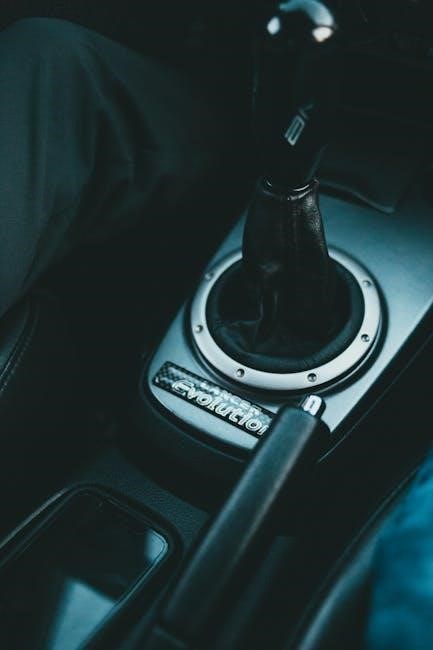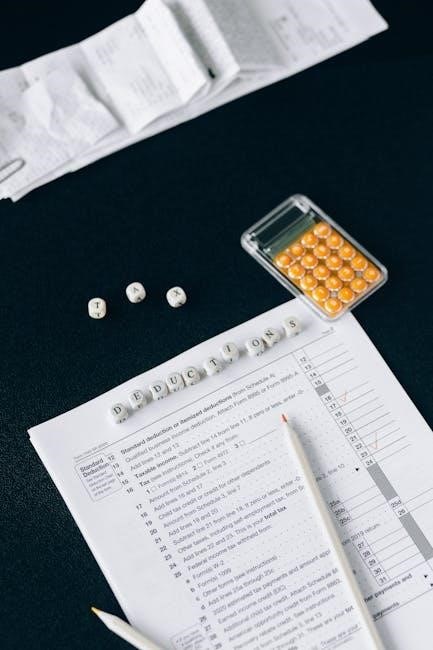Common Manual Gearbox Problems
Manual gearboxes, while robust, can experience issues․ Common problems include hard shifting, grinding noises, slipping clutches, sticking gear shifts, and unusual noises․ Oil leakage and gear slipping are also indicators of potential issues within the manual transmission system․

Hard Shifting Into Gear
Experiencing difficulty shifting into gear in a manual transmission vehicle is a common concern that can stem from various underlying issues․ Hard shifting can manifest as increased resistance when attempting to engage a gear, requiring more force than usual․ This problem can affect all gears or be specific to certain gears, making driving uncomfortable and potentially damaging the transmission over time․
Several factors can contribute to hard shifting․ Issues with the clutch, such as a dragging or failing clutch disc, prevent complete disengagement of the engine from the transmission, making gear engagement difficult․ Problems within the transmission itself, including worn synchronizers or damaged gears, can also cause resistance during shifting․
Additionally, the linkage between the gear shift lever and the transmission can become misaligned or damaged, leading to increased effort required for gear changes․ Addressing hard shifting promptly is crucial to prevent further damage and ensure smooth, reliable operation of the manual transmission system․
Possible Causes of Hard Shifting
Hard shifting can arise from several factors․ Common culprits include improperly adjusted or damaged linkage, clutch issues preventing full disengagement, or internal transmission problems like worn synchronizers․ Addressing these potential causes promptly can restore smoother gear changes․
Improperly Adjusted Linkage
An improperly adjusted linkage is a frequent cause of hard shifting in manual transmissions․ The linkage connects the gear shift lever to the transmission itself, and its precise adjustment is crucial for smooth gear engagement․ When the linkage is misaligned, it increases the effort needed to shift gears, making the process feel stiff or difficult․
This misalignment can stem from various factors, including wear and tear over time, accidental damage, or incorrect adjustments during previous repairs․ The result is often a situation where the driver has to exert excessive force on the gear shift lever, leading to a less-than-ideal driving experience․ Furthermore, forcing the gear shift can cause premature wear on other transmission components․
Diagnosing an improperly adjusted linkage typically involves a careful inspection of the linkage components․ A mechanic will check for any signs of looseness, damage, or misalignment․ Adjusting the linkage back to its correct specifications usually resolves the hard shifting issue, restoring smooth and effortless gear changes․
Bent, Jammed, Rusted, or Damaged Linkage
The manual transmission’s shift linkage, responsible for translating the driver’s gear selection to the gearbox, is vulnerable to physical damage․ Bent, jammed, rusted, or otherwise compromised linkage components can severely hinder the shifting process, leading to difficulty engaging gears or even complete immobility․ Rust, a common culprit, can seize moving parts within the linkage, preventing smooth operation․
Physical impacts, such as those from road debris or minor accidents, can bend or distort the linkage rods and levers․ Similarly, the accumulation of dirt and grime can cause jamming, especially in exposed areas․ Any damage to the linkage will disrupt the intended movement, requiring increased force to shift, potentially causing further damage to the transmission․
Addressing this issue necessitates a thorough inspection of the entire linkage system․ Bent or broken parts must be replaced, while rusted components may require cleaning and lubrication or replacement if the corrosion is too severe․ Ensuring the linkage is free from obstructions and properly aligned is crucial for restoring smooth and reliable gear changes․
Grinding Noise During Shifting
A grinding noise during shifting is a telltale sign of internal manual transmission issues․ This unpleasant sound often indicates a problem with the synchronizers, which are responsible for matching gear speeds for smooth engagement and preventing gear clash․
Synchronizer Problems
Synchronizers are critical components within a manual transmission, playing a vital role in ensuring smooth and seamless gear changes․ Their primary function is to synchronize the speeds of the gears before they engage, preventing the jarring and damaging effects of a direct clash․ When synchronizers fail, a grinding noise during shifting is a common symptom․
This grinding occurs because the gears are not properly matched in speed when the driver attempts to shift․ Worn or damaged synchronizers can no longer effectively perform their speed-matching task․ This leads to the gears colliding, resulting in the characteristic grinding sound․
Ignoring a grinding noise can lead to further damage to the gears themselves․ Continued operation with faulty synchronizers will accelerate wear, potentially requiring a more extensive and costly transmission repair or even a complete replacement․
Diagnosing synchronizer issues typically involves a thorough inspection by a qualified mechanic․ They may check for wear, damage, and proper functionality of the synchronizers within the transmission․ Repair options range from replacing individual synchronizers to overhauling the entire transmission, depending on the extent of the damage․

Slipping Clutch
A slipping clutch is a common issue in manual transmissions, often manifesting as a delayed or incomplete engagement between the engine and the transmission․ This can occur when the clutch disc, responsible for creating friction between the engine’s flywheel and the transmission, loses its ability to grip effectively․
One of the primary causes of a slipping clutch is wear and tear on the clutch disc itself․ Over time, the friction material on the disc wears down, reducing its ability to create the necessary grip․ Another cause can be oil or grease contamination on the clutch disc, which reduces friction․
Symptoms of a slipping clutch include increased engine RPMs without a corresponding increase in vehicle speed․ The car may struggle to accelerate, especially when climbing hills or carrying heavy loads․ You may also notice a burning smell coming from the clutch area․
Addressing a slipping clutch typically involves replacing the clutch disc, pressure plate, and throw-out bearing․ It is important to diagnose the root cause of the slippage to prevent premature wear on the new clutch components․ Ignoring a slipping clutch can lead to further damage to the flywheel and other transmission components․
Sticking Gear Shift
A sticking gear shift in a manual transmission describes the difficulty or inability to smoothly move the gear shift lever into the desired gear․ This can manifest as resistance when attempting to shift, or the lever becoming completely stuck in its current position․ Several factors can contribute to this frustrating issue․
One common cause is problems within the shift linkage system․ This system, consisting of rods, cables, and joints, connects the gear shift lever to the transmission․ If any of these components become bent, corroded, or damaged, it can impede the smooth movement of the lever․ Another potential culprit is low or contaminated transmission fluid․
Internal transmission problems, such as worn synchronizers or damaged gears, can also cause a sticking gear shift․ When these components are not functioning correctly, it can create excessive friction and resistance during shifting․ Additionally, issues with the clutch, such as a dragging or sticking clutch disc, can make shifting difficult․
Diagnosing a sticking gear shift involves inspecting the shift linkage, checking the transmission fluid level and condition, and evaluating the clutch operation․ In some cases, internal transmission repairs may be necessary to resolve the problem․ Addressing a sticking gear shift promptly can prevent further damage to the transmission and ensure safe driving․

Unusual Noises
Unusual noises emanating from a manual gearbox, such as grinding, whining, or clunking, often indicate internal problems․ These sounds can result from worn bearings, gears, or other damaged components within the transmission․ Prompt diagnosis is crucial․
Worn Bearings, Gears
Worn bearings and gears are frequent culprits behind unusual noises in manual transmissions․ Over time, the constant friction and stress within the gearbox can lead to the degradation of these crucial components․ Bearings, responsible for smooth rotational movement, may develop pitting, roughness, or excessive play due to wear․
Similarly, gears, which interlock to transfer power, can experience wear on their teeth․ This wear often manifests as rounding or chipping, altering the gear mesh and creating noise․ A grinding, whining, or clunking sound during operation is a telltale sign of worn bearings or gears․ Ignoring these noises can lead to further damage․
Reduced efficiency, difficulty shifting, and even complete transmission failure can occur․ Regular maintenance, including fluid changes, can help prolong the life of these components․ However, if unusual noises persist, a thorough inspection by a qualified mechanic is essential to identify the source and prevent more extensive repairs to the gearbox․

Gear Slipping
Gear slipping is a concerning manual transmission problem where the gearbox unexpectedly disengages from the selected gear, often reverting to neutral or engaging the wrong gear․ This issue can manifest during acceleration, deceleration, or even while maintaining a constant speed, posing a significant safety hazard to the vehicle and its occupants․
Several factors can contribute to gear slipping․ Worn or damaged gear teeth, faulty synchronizers, or issues within the shift linkage mechanism can prevent the gears from remaining properly engaged․ Low or contaminated transmission fluid can also exacerbate the problem, as it reduces the lubricating properties needed for smooth gear engagement and operation․
Diagnosing gear slipping requires a careful inspection of the transmission’s internal components․ A mechanic can assess the condition of the gears, synchronizers, and shift linkage, as well as check the fluid level and quality․ Addressing gear slipping promptly is crucial to prevent further damage to the transmission and ensure safe vehicle operation․ Repairs may involve replacing worn parts or overhauling the gearbox․
Manual Transmission Oil Leakage
Manual transmission oil leakage is a common issue that can lead to significant problems if left unaddressed․ The oil within the transmission serves as a vital lubricant, reducing friction between moving parts and dissipating heat․ A leak can result in reduced lubrication, increased wear and tear on internal components, and ultimately, transmission failure․
Several factors can contribute to oil leaks in a manual transmission․ Worn or damaged seals and gaskets are primary culprits, as these components are responsible for preventing oil from escaping․ Cracks in the transmission casing or housing can also create pathways for oil to leak out․ Over time, the constant exposure to heat and pressure can degrade these seals and casings․
Identifying and addressing oil leaks promptly is crucial․ Look for signs of oil puddles under the vehicle, particularly near the transmission area․ A visual inspection of the transmission casing can reveal obvious leaks․ If a leak is suspected, a mechanic can perform a thorough inspection to pinpoint the source and recommend the appropriate repair․ Replacing seals, gaskets, or repairing casing damage can resolve the leakage issues, ensuring optimal transmission performance and longevity․






























